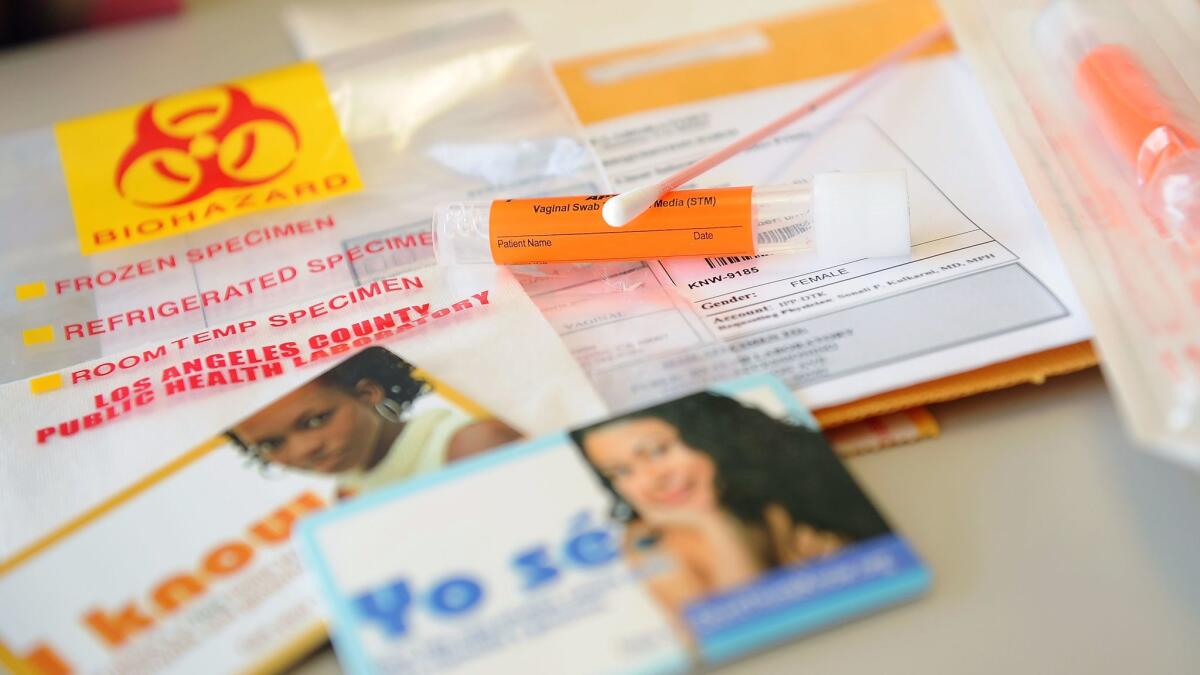STD rates hit another record high, with California near the top

- Share via
The number of Americans diagnosed with chlamydia, gonorrhea or syphilis reached a record high in 2016 for the second year in a row, with more than 2 million cases reported and particularly high rates in California, according to federal data released Tuesday.
Cases of these three sexually transmitted diseases have been increasing nationally since 2014, reversing a downward trend that began in 2006. Health officials say the rates reflect decreasing condom usage, a lack of awareness about STDs among doctors and patients, and a falling number of STD clinics.
“Increases in STDs are a clear warning of a growing threat,” Dr. Jonathan Mermin, director of the U.S. Centers for Disease Control and Prevention’s National Center for HIV/AIDS, Viral Hepatitis, STD and TB Prevention, said in a statement. “STDs are a persistent enemy, growing in number, and outpacing our ability to respond.”
All three STDs are curable, but if left untreated they can cause infertility or other serious health problems. People may not get tested because they don’t have symptoms or don’t notice their symptoms, but then are still able to spread the disease to others.
Health officials recommended that sexually active adults get regularly tested for STDs.
Officials said they were especially concerned that as the number of women with syphilis has jumped, so has the number of babies born with syphilis passed down from their mothers. Congenital syphilis, as it is known, can cause stillbirths or permanent disabilities. Since 2012, the number of babies born with congenital syphilis nationwide nearly doubled, reaching 632 last year.
The problem is particularly severe in California, which has the nation’s second-highest rates of congenital syphilis. In 2012, 35 babies were infected. Last year, there were 206.
“The number of reported STDs in California is increasing at a concerning rate,” Dr. Karen Smith, director of the California Department of Public Health, said in a statement Tuesday. “This is the third year in a row that we have seen increases in chlamydia, gonorrhea and syphilis.”
More than a quarter-million Californians were infected with either syphilis, chlamydia or gonorrhea last year, which constitutes a 40% jump compared with five years ago, state officials said.
Chlamydia, which is most likely to infect women under 30, made up the majority of those cases. It is the most commonly reported medical condition in the state and the country. There were 1.6 million cases nationwide and more than 198,000 in California last year.
The cases in California represent the highest level of the disease since 1990, with the biggest increase last year in the San Francisco region, state officials said. San Francisco also had higher rates of gonorrhea and syphilis than any other part of the state last year.
Los Angeles, Fresno and Kern counties also had rates of all three STDs that were above the state average.
Nationwide and in California, officials have struggled with rising syphilis rates. In the late 1990s, rates of the disease were so low that officials believed they’d be able to eradicate the disease. But cases have been steadily increasing since then, mostly among gay and bisexual men.
That growth has recently been passed onto women, which is particularly dangerous because of the possibility of congenital syphilis.
In California, which has the third highest syphilis rates in the nation, cases among women of reproductive age increased 50% between 2015 and 2016, according to new state data.
Dr. Gail Bolan, director of the CDC’s division of STD prevention, said the increase in gonorrhea rates in 2016 was of particular concern as more strains become resistant to antibiotics. There were once several antibiotics that could cure the infection, but the bacteria have mutated and now are harder to treat.
“We’re down to our last class of antibiotics that we have available to treat gonorrhea,” Bolan said. “In the past, we just moved on to the next class of antibiotics, but we’re now on the edge. ... We want to make sure we keep the threat of these potentially resistant strains at a low level.”
To read the article in Spanish, click here
soumya.karlamangla@latimes.com
Twitter: @skarlamangla
ALSO
Hepatitis A outbreak sparks call for L.A. to give homeless people more street toilets
Mosquitoes spread deadly diseases, and public health experts hope to fight back with this new emoji
UC Irvine aims to transform public health with record-breaking $200-million donation
UPDATES:
4:05 p.m.: This article was updated with additional details and background about the STD problem in California.
This article was originally published at 2:50 p.m.
More to Read
Sign up for Essential California
The most important California stories and recommendations in your inbox every morning.
You may occasionally receive promotional content from the Los Angeles Times.














